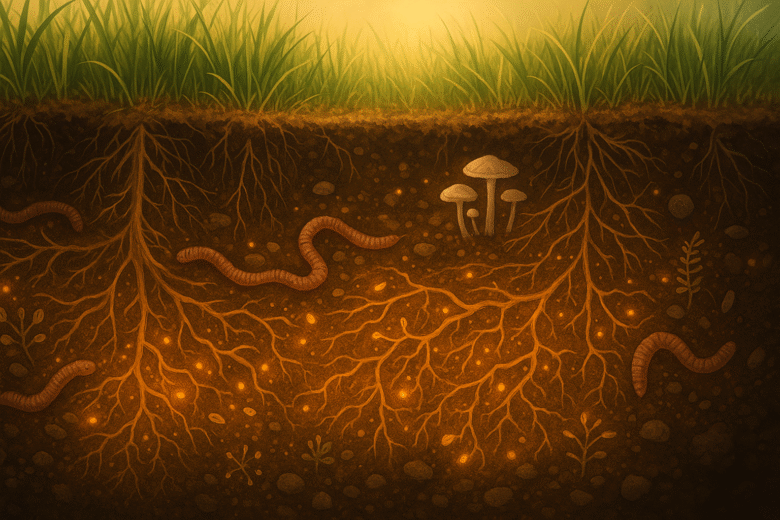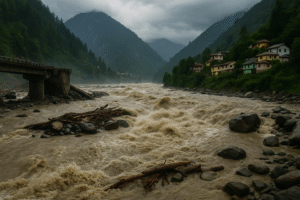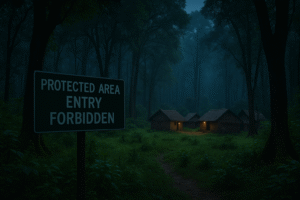Here’s a fun fact: a single handful of healthy soil contains more living organisms than there are humans on Earth. That’s right—tiny bacteria, fungi, worms, insects, and roots are working overtime beneath our feet, often unnoticed but indispensable to life above ground.
When I say, “The Secret Life Beneath Our Feet,” I’m not being poetic—I’m being blunt. Beneath every step we take lies an underground universe, one that silently dictates the air we breathe, the food we eat, and even the climate we’re struggling to stabilise. And yet, most of us think of soil as just “dirt.” That ignorance may be one of the most dangerous mistakes humanity makes.
Soil Is Not Dirt
Soil is alive. It is a dynamic, breathing ecosystem. Calling it “dirt” is like calling a rainforest “green mess.” Beneath the surface is a community of creatures—microbes, nematodes, fungi, ants, beetles, and earthworms—all playing roles that keep our world functioning.
These organisms:
- Break down dead matter, recycling nutrients back into the food chain.
- Build soil structure, allowing water to infiltrate instead of flooding our fields.
- Fix nitrogen and other elements that plants need to grow.
- Store carbon, acting as a hidden climate regulator.
Without these underground services, agriculture would collapse. Cities would flood more often. And the atmosphere would choke on even more carbon dioxide.
The Underground Workforce
Earthworms: Known as “ecosystem engineers,” they aerate soil, recycle organic matter, and create fertile ground for crops. Charles Darwin once said, “It may be doubted if there are any other animals which have played so important a part in the history of the world as these lowly organized creatures.”
Fungi: Mycorrhizal fungi form symbiotic partnerships with plant roots, extending their ability to absorb nutrients and water. Trees in forests literally “talk” to one another via these fungal networks—sometimes called the “Wood Wide Web.”
Bacteria: Millions of species live in soil, some fixing nitrogen from the air into forms plants can use, others decomposing toxic materials.
Insects & Arthropods: Termites recycle wood, beetles break down debris, and ants turn the soil over. These small engineers keep the wheel of life turning.
Case Study 1: India’s Farmers and Soil Decline
In India, decades of chemical fertilizer overuse have stripped soils of their organic matter. As a result, productivity is falling, pests are rising, and farmers are spending more on inputs to get fewer returns. Restoring soil health isn’t just ecological—it’s economic survival.
Case Study 2: Dust Bowl of the 1930s
When U.S. farmers ploughed up prairie grasslands without understanding soil ecosystems, they destroyed root networks that anchored the soil. Combined with drought, this triggered the infamous Dust Bowl—massive dust storms that displaced millions. It was a man-made disaster born of disrespecting the soil’s secret life.
Case Study 3: The Carbon Sink Underfoot
Scientists estimate that soils store three times more carbon than the atmosphere. But deforestation, intensive farming, and erosion release that carbon back into the air. Protecting soil health is as critical for fighting climate change as cutting emissions. Yet it barely features in climate debates.
Why the Secret Life Beneath Our Feet Is in Danger
Industrial Agriculture: Heavy ploughing, pesticides, and synthetic fertilizers kill microbes and compact soil.
Deforestation & Urbanisation: Exposed soils erode and lose organic matter.
Pollution: Heavy metals and plastics poison underground ecosystems.
Climate Change: Heat and drought stress microbial communities and alter soil chemistry.
The Food Security Connection
Healthy soils produce healthy food. Studies show that nutrient-rich soils lead to crops with more vitamins and minerals. Poor soils, by contrast, yield calorie-rich but nutrient-poor harvests—contributing to the global “hidden hunger” of micronutrient deficiencies.
The Ethical Question: Are We Soil Parasites?
Here’s a provocative thought: humans behave less like stewards of soil and more like parasites. We extract nutrients, dump chemicals, erode its structure, and expect it to keep producing endlessly. If any other species behaved this way toward its host, we’d call it destructive. Maybe it’s time we rethink our relationship with the very ground we walk on.
Solutions: Healing the Ground Beneath
Organic Matter Returns: Composting, crop residues, manure—feeding soil life instead of starving it.
Regenerative Agriculture: Practices like no-till farming, crop rotation, and cover cropping restore soil ecosystems.
Agroforestry: Mixing trees with crops stabilises soil and boosts biodiversity.
Policy and Incentives: Governments must subsidise soil health practices, not just chemical fertilizers.
Citizen Action: From kitchen compost bins to planting native plants, even small acts enrich soil in cities and villages alike.
Conclusion
The Secret Life Beneath Our Feet is not a metaphor—it’s a survival story. Soil is not dirt to be scraped, dumped, or poisoned. It is the living foundation of our existence. If we continue to degrade it, we won’t just lose crops—we’ll lose climate stability, clean water, and ultimately, life itself.
The next time you walk across a patch of land, remember; there’s a bustling world underfoot. Will you step lightly, or will you keep crushing the very life that sustains you?
Author’s Note
When I began writing about soil, I worried it might sound “boring.” But the more I dug (pun intended), the more extraordinary it became. Soil is not passive—it’s alive. It deserves reverence, not neglect.
G.C., Ecosociosphere contributor.
References and Further Reading
- United Nations Food and Agriculture Organization (FAO) Report on Soil Health
- Soil Biodiversity and the Wood Wide Web — Nature Journal
- United Nations Convention to Combat Desertification (UNCCD)
- World Resources Institute: The Carbon Sink in Soil
- National Geographic: The Dust Bowl
- Our World in Data: Soil and Agriculture





Comments
Real great visual appeal on this web site, I’d rate it 10 10.